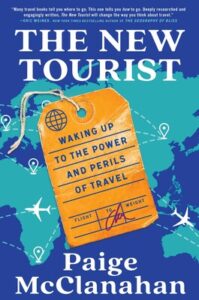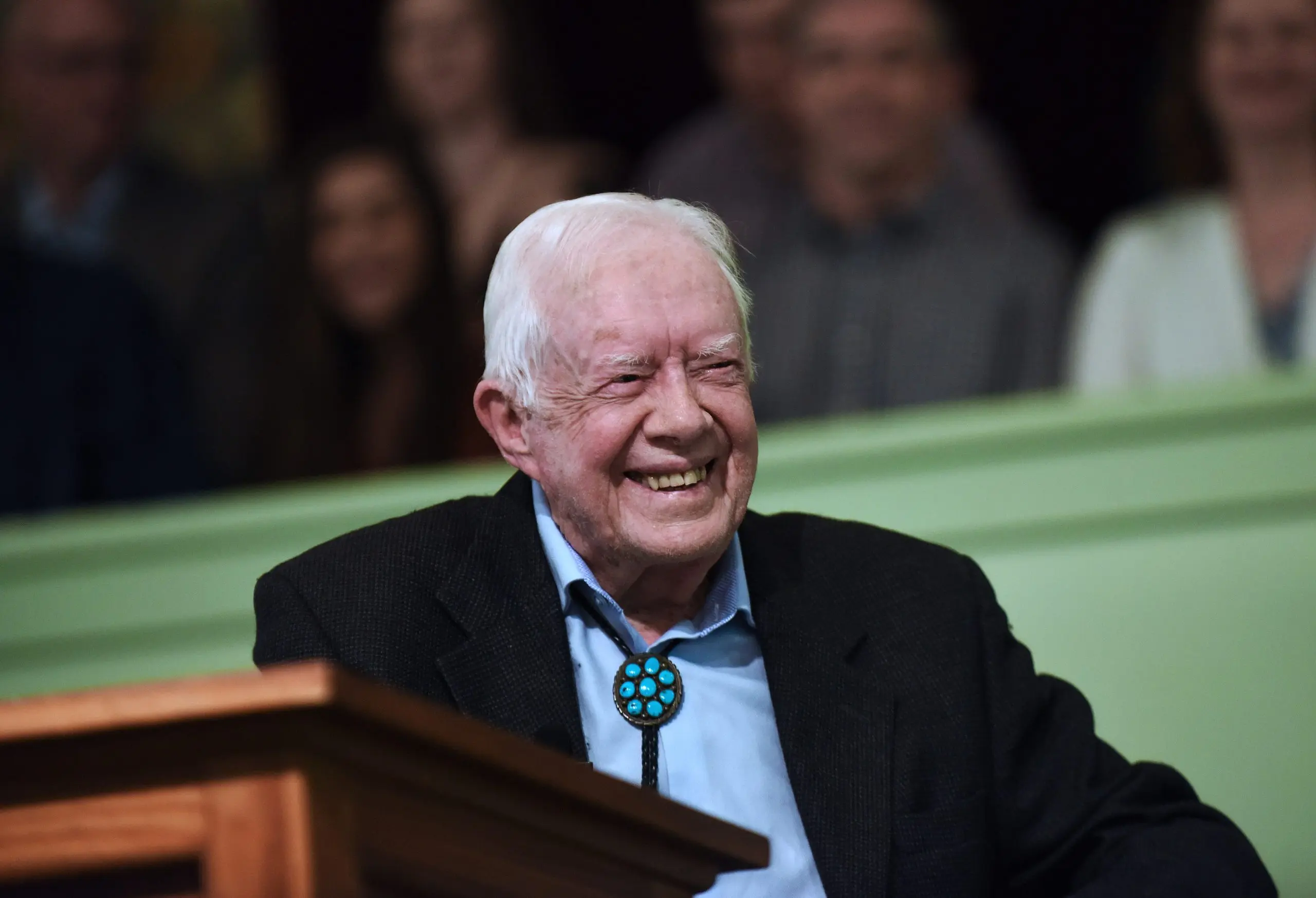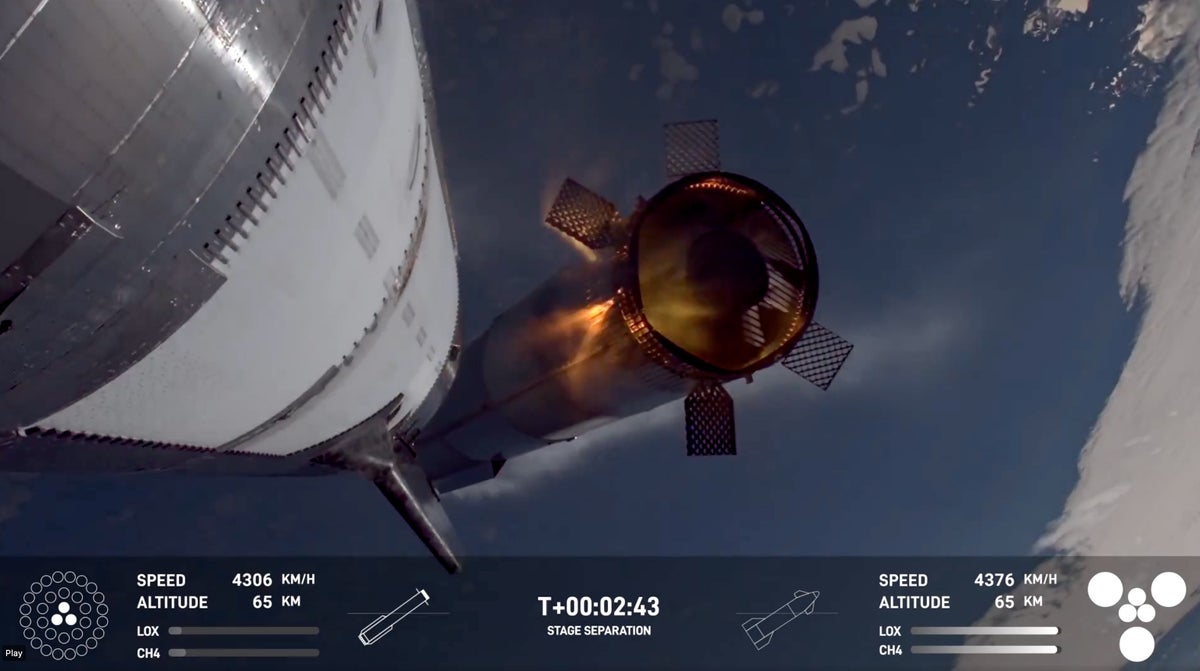On July 4, 1972, a pair of young newlyweds named Tony and Maureen backed out of the driveway of a family home in the south of England. They were driving a used blue minivan that they had bought for the princely sum of £65, and their goal was to get to India. Or somewhere. They had a trunk full of food, cooking equipment, some spare parts for the car, a stack of traveler’s checks, some sleeping bags, and an old tent. As he eased the car out of his parents’ driveway, Tony called out to his mum and dad that they’d be back in a year. Fate had other plans.
Article continues below
So begins the story of Lonely Planet, the most powerful travel brand of the twentieth century—a company that would influence the movements and experiences of tens of millions of travelers, while also shaping the fate of countless businesses and, in some cases, entire communities. But the five-and-a-half-month overland journey that led to the company’s founding was hardly unprecedented. In many ways, those newlyweds—Tony and Maureen Wheeler—were typical young baby boomers: they were eager to see the world, and they wanted to do so in a way that had been both unthinkable and, in many cases, physically impossible for their parents. As they set off on their trip, Tony and Maureen were following in the footsteps of thousands of young travelers who’d already blazed the “Hippie Trail” across Asia. But these young newlyweds were also exceptional, which is why we’re still talking about them today: Tony and Maureen’s trip to India and beyond went on to inspire a business that would tap into the restless power of their generation, serving the millions of young Westerners who shared their drive to escape the confines of the comfortable postwar societies in which they’d been raised. The couple’s business, which they would found in Australia at the other end of that now-fabled 1972 journey across Asia, would fundamentally change the way tourists experience the world. And it would change the world, too.
Tony and Maureen’s trip to India and beyond went on to inspire a business that would tap into the restless power of their generation.
But back in the summer of 1972, the Wheelers were just a couple of kids. Maureen, who was born in Belfast in 1950, had quit her job as an office assistant in London a few weeks earlier. Tony, age twenty-five and fresh out of business school, had just been offered a job at Ford Motor Company’s office in Essex; he declined, but asked if they would hold the position for him while he traveled for a year, and they agreed. And so they set off, fully believing that their jaunt across Asia would be nothing more than a little adventure before they settled down to a steady, middle-class life in England.
The Wheelers could have chosen to travel with one of the several Hippie Trail tour operators that were selling seats on buses that would make the whole trip across Asia in two or three months. But tagging along with a group wasn’t their style. Also, they couldn’t afford it. So they figured it out themselves, and it turned out to be just the kind of adventure these two young people craved: they got caught in a snowstorm in the Italian Alps; slept on the beach on the Greek island of Lesbos; bumped into the shah’s motorcade in Iran; then sold their car and hung out with the hippies in Kabul. (“If you can remember it clearly then clearly you weren’t there,” Tony recalls of Afghanistan in the early seventies.) From there, it was a bus to Pakistan, then on to India, Nepal, back to India, then a short flight to Bangkok because it was impossible to cross Burma by land. The couple hitchhiked south across Thailand and on through Malaysia and Singapore, where the immigration officer suggested that Tony cut his hair if he planned to stay for more than twenty-four hours. A fifty-pound loan from Tony’s parents was enough to get them on a ship to Jakarta and then a bus to Bali, where they set out on the final leg of the trip: a one-week stint as crew on a yacht bound for the white sand coast of Western Australia. But the winds died, the engine broke, and one of their water tanks sprung a leak. By day eight on the yacht, they were eating the last of their food stores and severely rationing their water.
But they made it. A fellow crew member snapped a photo of the grinning couple on an empty Australian beach, thirty seconds after they’d set foot on land, their meager belongings scattered on the sand below them. They’d run out of gas multiple times in Europe; had their belongings stolen in Italy; been briefly held at gunpoint while camping on the coast of the Black Sea; and gotten the shits in just about every country since Afghanistan. (Already slim when they started out, Tony and Maureen each lost more than ten pounds in the five and a half months it took them to get from England to Australia.) They’d covered over ten thousand miles, and by the time they made it to Sydney they had precisely twenty-seven cents left to sustain them.
*
What did the young Wheelers have to guide them in all of this? The bookshops they could have visited back in England in 1972 would have had precious little to offer in the way of practical advice for their route. Travel guidebooks had been popular in Europe for well over a century, but those that existed in the early seventies didn’t cater to the likes of Tony and Maureen. Series like the Blue Guides and Baedeker Guides that were so beloved by the Victorians were still going strong, but these would have been of little interest to them. For one thing, the guides were mostly devoid of information on things like cafés and restaurants, let alone nightlife; any aspect of a nation’s culture that was more recent than about the eighteenth century was usually considered unworthy of description. There were some books to consult that had a more up-to-date feel, but the range of the places they covered was still limited, and the audience they served was very different from the restless young baby boomer crowd. Arthur Frommer and Eugene Fodor were both producing popular travel guides at that point, and their books marked the beginning of an important shift in the genre. Frommer, born in Missouri in 1929, started publishing travel tips for his fellow GIs when he was serving in the military in Europe in the 1950s. He published Europe on $5 a Day for civilians after he got home, proving to his increasingly affluent American audience that they could indeed afford to travel on the Continent. Eugene Fodor, born in what’s now Slovakia in 1905, was already a few steps ahead of him, having published his first guidebook in 1936, a 1,200-page guide to Europe that he researched and wrote entirely by himself. Two years later, the updated edition hit the New York Times bestseller list.
Fodor and Frommer were groundbreaking in that they were among the first to respond to the practical needs of travelers, and to treat travel as an exploration rather than a dull but character-building accumulation of historic sites and masterpieces. They both offered practical tips on how to get around, as well as information on modern society and culture. And Frommer in particular proved that seeing the sights of Europe was very much within the budget of most middle-class Americans. Unlike their Victorian precedents, these new midcentury guides also pushed readers to look for human connections when they traveled. In fact, Fodor’s motivation for his first book came in part from the lack of a “human element” in the guidebooks he could find in the thirties. And so he encouraged his readers to go beyond the sights of a place, and spend time with people “whose customs, habits and general outlook are different from your own.”
This was all very much in line with Tony and Maureen’s way of thinking. But these savvy young boomers didn’t necessarily need help navigating their way around Europe, where Frommer and Fodor continued to focus (although Fodor, with the help of the CIA, would branch out significantly in the 1970s). Nor were they interested in the moderate to upscale hotels that the Fodor’s guides would list, or the major cities of Europe, which were the bread and butter of the Frommer’s guide. That wasn’t what the young Wheelers were about. They wanted to know where they could pitch their tent in Tehran, how to ask for marijuana in Kabul, and when the monsoon season would hit Malaysia. To find that kind of information, they were going to have to be a little more creative. Only one helpful source would have been reliably available to Tony and Maureen in London at the time, and that was Overland to India and Australia. Published by BIT, an alternative information and exchange service based in London, BIT guides were a sort of hard-copy, baby boomer version of Craigslist. Much of the Asia overland guide was crowdsourced, and misinformation was rife—“You know some people were eight miles high when they wrote this stuff,” Tony later recalled—but it was the single best resource they had. The edition that was published in April 1972, a few months before the Wheelers set off, could be obtained for a “minimum donation” of fifty pence and consisted of a grand total of twenty stapled pages. Still, it was better than nothing.
Had the Wheelers wanted to make a similar trip from, say, London to South Africa, they would have been equally hardpressed to find detailed information on how to navigate their route. BIT also published a guide to overlanding in Africa, but it was a mere scattershot collection of travelers’ stories, nothing like a comprehensive guide to the continent. And what if the Wheelers had wanted to chart their adventure along the “gringo trail” that was beginning to emerge between Mexico and the southern tip of Patagonia? The sole reliable resource they could have found in Britain would have been The South American Handbook, whose England-based editors updated the guide using information sent in from travelers. In 1972, with precious few exceptions, dedicated and well-researched English-language travel guides to individual countries in Africa, South America, and Asia simply didn’t exist—for travelers of any budget.
But that’s not to say that Tony and Maureen had nothing to guide them. As they would discover soon after setting off, their single best source of information was the other Western boomers whom they’d encounter on the road, often at hippie magnets like the Pudding Shop in Istanbul, Chicken Street in Kabul, or Freak Street in Kathmandu. Whenever they’d bump into fellow travelers, Tony and Maureen would pump them for information—and share information in return. Before long, they’d accumulated quite a bit of advice to share. On each day of the trip, Tony, always an assiduous notetaker, would jot down things like how far they’d traveled, how much they’d paid for their meals, what the roads were like, how they’d obtained their visas, as well as things he picked up about the local culture, religion, and history. These notes would later prove to be a very valuable resource indeed.
*
“The Asian overland trip has become so popular in the past five years that there’s almost a groove worn in the face of the map.” So begins Across Asia on the Cheap, the slim, hand-stapled book that the Wheelers published within a year of arriving in Australia.
They hadn’t set out to write a guidebook, but soon after they made it to Sydney, they found there was a huge interest in the notes and anecdotes they’d gathered along their route. Others wanted to follow in their footsteps. Demand was so great that the young Wheelers, who were still trying to earn money to buy their flights home to England, started to wonder if they could find a way to charge people for the information they were sharing. One day, Tony suggested they write a guidebook. “But how would we find a publisher?” Maureen asked. “We don’t need a publisher,” Tony replied. “We can publish it ourselves.”
And so they did. They wrote out the pages by hand in the evenings, after coming home from the office jobs they’d landed in Sydney. They wrote up their notes on how to score a fake student ID for discounts on flights and train tickets; which maps might get people in trouble at the Pakistani border; how “chicks” could “pick up easy money” working for the “quite respectable” escort services in Singapore; what they really thought of travel agents (“never fully believe them”); and how easy it was to obtain “dope” along the route (“If that’s what you want then you are going to the right places!”). They included information on local history, culture, religion, and climate. They also offered some details on organized overland tours that travelers could join, but they urged people to embrace the adventure and go it alone: “If you don’t mind roughing it a little you can join the thousands of people who really have dropped out of the nine to five rat race,” Tony wrote.
Maureen typed up the handwritten pages on a typewriter she borrowed from her office, while Tony drew the maps and illustrations by hand. They found a small counterculture printer, Tomato Press, that typeset the book, and a friend of a friend with a printing press in his basement churned out the pages. They stapled together the sixteen-page “signatures” they received from the printer, then sheared the books’ edges straight with a borrowed guillotine. The book was emblazoned with the name and logo of their fledgling publishing house, which appeared in a string of bubbly lowercase letters, backed by a thin circle, that Tony had sketched himself: lonely planet.
The Wheelers’ first guide (which carried only Tony’s name on the cover) was just under a hundred pages and sold for $1.80, in Australian dollars. Their first print run of 1,500 copies sold out within ten days of their first review in the Sydney Sun-Herald. They printed 3,500 more, and Tony took a suitcase of books to Melbourne to sell copies to booksellers there. Soon they ordered a second print run of 3,500, and they decided to delay their planned return to London.
They thought they might go traveling again, this time around Southeast Asia, where the Vietnam War was finally starting to die down. Most people in the West still thought of Southeast Asia as a war zone, but Tony and Maureen had seen for themselves that countries like Thailand, Malaysia, Indonesia, and Singapore held huge potential for tourism. Tony would later remember the region as “almost a terra incognita” in the early seventies. They decided they’d try to write another guide.
Tony and Maureen had no way of knowing it at the time, but they were at the forefront of a small group of restless young adults who would collectively help to open up whole swathes of the planet to adventure-seeking, budget-minded Western travelers who wanted to avoid the traditional tourist infrastructure.
Tony and Maureen never made it back to England in the end, though they did move from Sydney to Melbourne, where they’d remain for more than thirty years. Their second guidebook, South East Asia on a Shoestring, had sold well, just like their first. (Tony had chosen a different layout for the book. He liked the handy size and two-column format of Reader’s Digest and thought it would work well for a travel guidebook, too. The format would remain pretty much unchanged for nearly fifty years.) The couple followed up the Southeast Asia book with a guide to trekking in the Himalayas, quickly followed by a travel guide to Nepal, a country that had been largely closed to foreign tourists until the 1950s. By 1977, Tony and Maureen were publishing (and doing their best to update) eight different guidebooks, and they were struggling mightily to manage all the work. Expenses were high and their cash flow was tight. For a couple of years, they weren’t sure if they could hold things together.
Lonely Planet had come a long way from its scrappy beginnings, and so had Tony and Maureen.
The company’s breakthrough came in 1981, when they published their first guide to India, a book that, according to Tony, “immediately kicked Lonely Planet into a higher and more stable orbit.” Other guides to the country had been written, but Tony felt they weren’t aimed at the new breed of travelers—the same people who were eating up Lonely Planet’s other titles. He and Maureen spent five months trekking around central India; they hired two experienced friends—the British travel writer Geoff Crowther and the author Prakash Raj, based in Nepal—to cover the north and south. Tony’s hunch was right. India: A Travel Survival Kit “lit up their sales charts” when it appeared, and within weeks they ordered the first of many reprints. The book’s commercial success kick-started a period of rapid growth for the company, whose catalog would quadruple by the mid-eighties.
*
As Lonely Planet’s sales grew, so, too, did the brand’s influence. Already beloved by young Australian backpackers, the company soon developed a faithful following among their counterparts in the United States, where Lonely Planet sold some 100,000 copies of its guides and phrase books in 1985, the year after it opened its first distribution center in California. Within a decade, the United States became Lonely Planet’s biggest market. Among the company’s many early devotees was a well-traveled American business reporter named Nicholas D. Kristof.
“The Lonely Planet guidebooks are, quite simply, like no others,” Kristof, still in his mid-twenties, wrote in a story for the Travel section of the New York Times in February 1986, after opening the piece with an account of a restless night he spent on the slow train to Ouagadougou, the capital of Burkina Faso. While most guidebooks stuck to the typical listings of hotels and tour operators, Kristof noted, Lonely Planet would tell its readers “how to hop a free ride on a boat on Nicaragua’s Caribbean coast, where to find families to stay with in Timbuktu and where to find penicillin in Bangkok.” He went on to describe a small hotel in India that bore a sign saying “Tony Wheeler slept here,” alongside the page from the hotel register that Tony had signed years before. “Travelers gaze at it wistfully,” Kristof wrote; “the hotel has been touched by the gods.”
It’s true that Tony himself (and Maureen, to a lesser extent) had become celebrities among adventure travelers, and their fame would soon spread. In 1996, a year in which Lonely Planet published 216 titles in eleven languages, the New York Times Magazine profiled the Wheelers, with a focus on Tony, whom the piece described as the “trailblazing patron saint of the world’s backpackers and adventure travelers” and “a man whose name makes hostel owners and budget restaurateurs tremble from Polynesia to the Pampas.”
By the time that profile appeared, Lonely Planet had come a long way from its scrappy beginnings, and so had Tony and Maureen. While many of their competitors—including the Rough Guides series as well as the Frommer’s and Fodor’s guides—had been scooped up by major publishing houses, the Wheelers had transformed Lonely Planet into the largest independent travel book company in the Anglophone world. Their formula had been to corner the growing market for travel guides to Asia, Africa, and Latin America—and they’d largely succeeded. By 1996, Lonely Planet was churning through $15 million in revenue every year, and according to the New York Times Magazine, their guides had become “the gospel of adventure travel” for “tens of millions of globetrotting readers.”
As their guidebooks gained traction, the Wheelers grew up alongside their company. They continued to travel and research their books, especially Tony. But by the mid-nineties, they had two teenage children at home and were well into middle age. The Wheelers were still in Melbourne, although instead of occupying a nondescript apartment near the city center, they now lived in a home with its own Balinese water garden. And Tony had a lipstick red Ferrari parked in the garage.
As Lonely Planet’s size and influence grew over the years, so too did the global population of international travelers. In 2007, the year in which the Wheelers would initiate the sale of Lonely Planet to the BBC, 913 million tourists crossed an international border, well over four times the figure from 1973, the year they published their first guidebook. Was some of that global rise in international travel driven by guidebooks themselves? It’s possible there was a degree of influence, but two much bigger forces were driving the rising travel trend over the next decade: the growth of the global middle class and the increasing ease of making travel bookings online.
And, of course, the power of Lonely Planet wasn’t to last: the digital world was coming, and it was coming fast. “Print Travel Books Are Dead, and There’s No Good Replacement,” ran a Time magazine headline in March 2013. A month later, a journalist writing for the Atlantic wondered aloud whether the days of wandering around Europe with a guidebook in hand were long gone. Her conclusion: “It certainly looks that way.”
__________________________________

Excerpted from The New Tourist: Waking Up to the Power and Perils of Travel by Paige McClanahan. Copyright © 2024 by Paige McClanahan. Reprinted by permission of Scribner, a division of Simon & Schuster, LLC.


























































